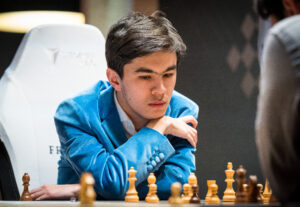Erdogmus-Sindarov
Just like the first round, Erdogmus chose the Exchange Variation in the Ruy Lopez. Sindarov met this with the most solid move, 5….f6, and rapidly achieved a balanced position. The balance was never disturbed, and at move 40, all pieces had been exchanged and a draw was agreed.
Rapport-Tan
Rapport played 5.d3 against Tan‘s Ruy Lopex. The game seemed to be heading for a draw by repetition in an equal position, but Rapport decided to make a last try. Right after move 40, he decided to sacrifice the exchange, which to begin with looked promising. However, Tan found a real good defense where she sacrificed two pawns by 49….d5, followed by 50….e4+, to create counter-play with an advanced pawn. Rapport still had drawing chances, but he must have miscalculated at some point, and resigned just a few moves later.
Ivanchuk-Grandelius
Early on in the Slav Defense, Ivanchuk sacrificed a pawn to get a solid center. The game became very complicated and both players, but most of all Ivanchuk, used up a lot of time. Under time pressure, Ivanchuk missed that 29.c6 could be met with the strong 29…h6, winning a pawn. However, a couple of moves later, Grandelius made a mistake when he played 35….g5, which allowed Ivanchuk to complicate things with 36.f6. After move 40, Grandelius still had a clear advantage, and yet another mistake from Ivanchuk allowed Grandelius to finish things with the elegant 44….f5.
Robson-Lami
With the white pieces in the Sicilian Najdorf, Robson played the very unusual 12.a4. Lami came under pressure, but found a creative defense, where he got a strong black square bishop to compensate for his poor pawn structure. For a while, with both players in time trouble, it looked like black was going to get the upper hand. However, l‘Ami did not find the best continuation, and the game ended witn a draw by repetition.
